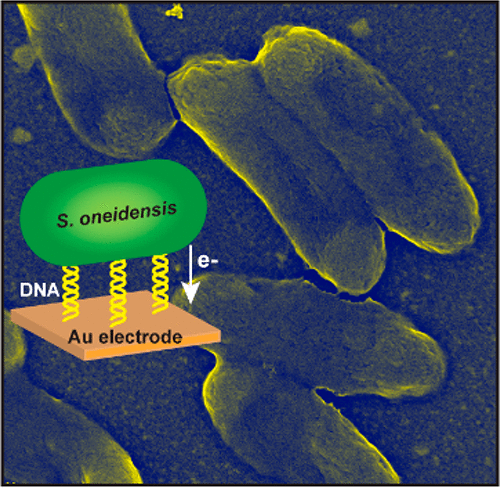当前位置:
X-MOL 学术
›
ACS Cent. Sci.
›
论文详情
Our official English website, www.x-mol.net, welcomes your
feedback! (Note: you will need to create a separate account there.)
DNA Hybridization To Interface Current-Producing Cells with Electrode Surfaces
ACS Central Science ( IF 12.7 ) Pub Date : 2018-07-02 00:00:00 , DOI: 10.1021/acscentsci.8b00255 Ariel L. Furst 1 , Matthew J. Smith 1 , Michael C. Lee 1 , Matthew B. Francis 1, 2
ACS Central Science ( IF 12.7 ) Pub Date : 2018-07-02 00:00:00 , DOI: 10.1021/acscentsci.8b00255 Ariel L. Furst 1 , Matthew J. Smith 1 , Michael C. Lee 1 , Matthew B. Francis 1, 2
Affiliation

|
As fossil fuels are increasingly linked to environmental damage, the development of renewable, affordable biological alternative fuels is vital. Shewanella oneidensis is often suggested as a potential component of bioelectrochemical cells because of its ability to act as an electron donor to metal surfaces. These microbes remain challenging to implement, though, due to inconsistency in biofilm formation on electrodes and therefore current generation. We have applied DNA hybridization-based cell adhesion to immobilize S. oneidensis on electrodes. High levels of current are reproducibly generated from these cell layers following only 30 min of immobilization without the need for the formation of a biofilm. Upon incorporation of DNA mismatches in the microbe immobilization sequence, significant attenuation in current production is observed, suggesting that at least part of the electron transfer to the electrode is DNA-mediated. This method of microbe assembly is rapid, reproducible, and facile for the production of anodes for biofuel cells.
中文翻译:

DNA杂交使电流产生细胞与电极表面接触
随着化石燃料与环境破坏的联系越来越紧密,可再生,负担得起的生物替代燃料的开发至关重要。人们通常认为Shewanella oneidensis是生物电化学细胞的潜在组成部分,因为它能够充当金属表面的电子供体。但是,由于电极上生物膜形成的不一致以及由此产生的电流,这些微生物的实施仍然具有挑战性。我们已经应用了基于DNA杂交的细胞黏附来固定沙门氏菌在电极上。仅固定30分钟,即可从这些细胞层中产生高水平的电流,而无需形成生物膜。在微生物固定序列中掺入DNA错配后,观察到电流产生显着衰减,这表明至少部分电子转移至电极是DNA介导的。这种微生物组装的方法是快速,可重现的,并且易于生产用于生物燃料电池的阳极。
更新日期:2018-07-02
中文翻译:

DNA杂交使电流产生细胞与电极表面接触
随着化石燃料与环境破坏的联系越来越紧密,可再生,负担得起的生物替代燃料的开发至关重要。人们通常认为Shewanella oneidensis是生物电化学细胞的潜在组成部分,因为它能够充当金属表面的电子供体。但是,由于电极上生物膜形成的不一致以及由此产生的电流,这些微生物的实施仍然具有挑战性。我们已经应用了基于DNA杂交的细胞黏附来固定沙门氏菌在电极上。仅固定30分钟,即可从这些细胞层中产生高水平的电流,而无需形成生物膜。在微生物固定序列中掺入DNA错配后,观察到电流产生显着衰减,这表明至少部分电子转移至电极是DNA介导的。这种微生物组装的方法是快速,可重现的,并且易于生产用于生物燃料电池的阳极。









































 京公网安备 11010802027423号
京公网安备 11010802027423号